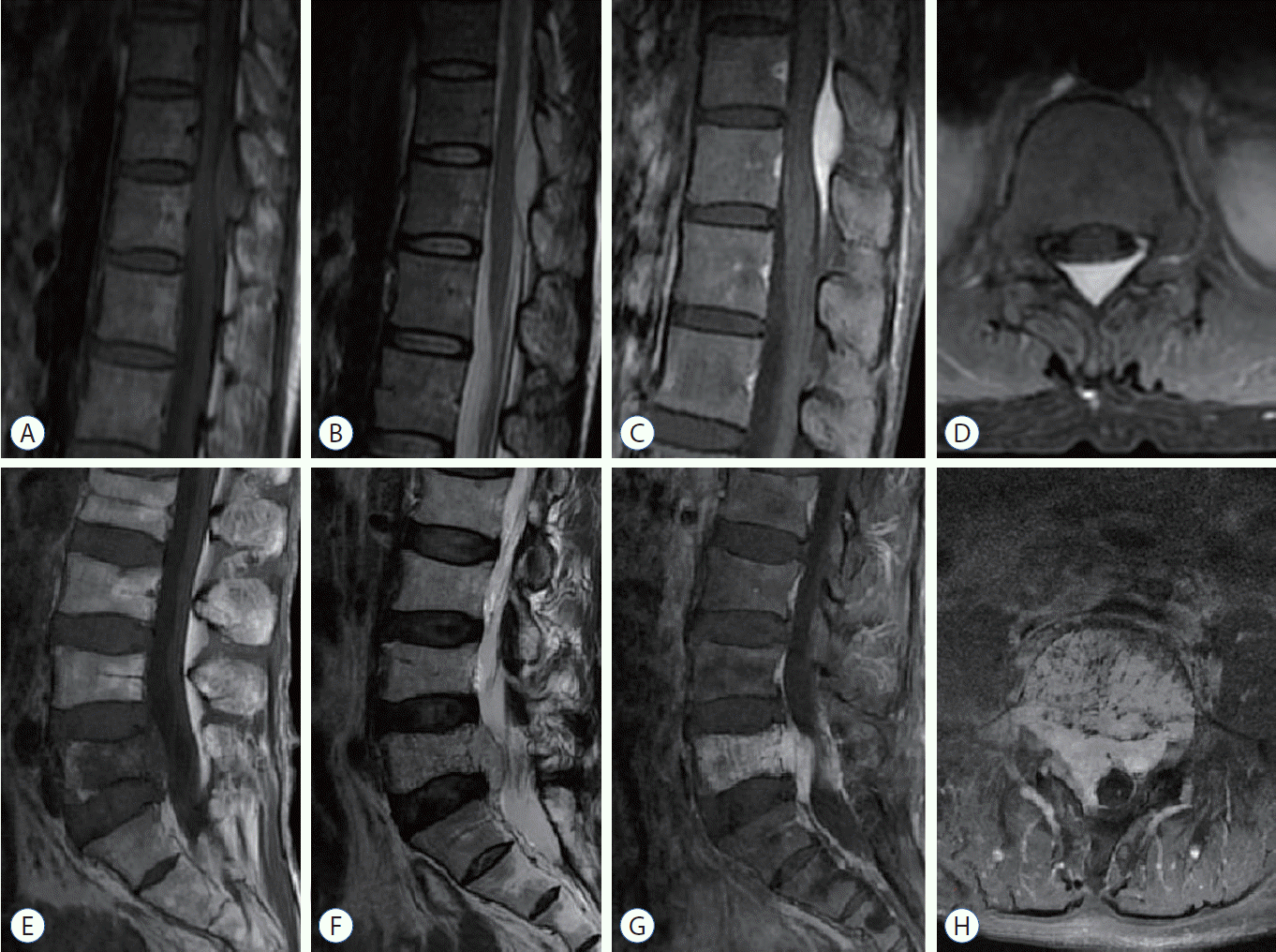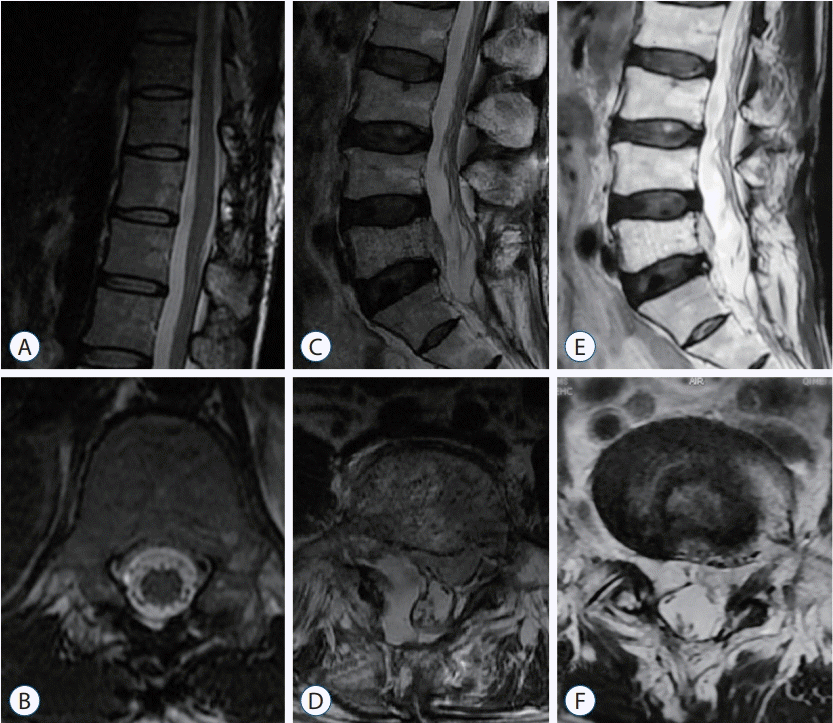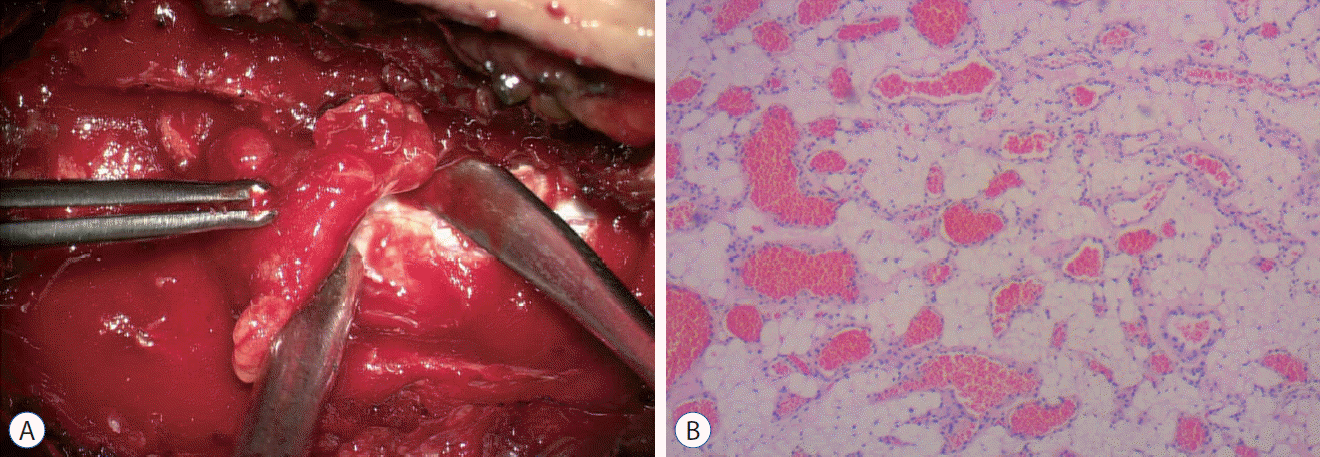1. Anson JA, Cybulski GR, Reyes M. Spinal extradural angiolipoma: a report of two cases and review of the literature. Surg Neurol. 34:173–178. 1990.

2. Bender JL, Van Landingham JH, Manno NJ. Epidural lipoma producing spinal cord compression. Report of two cases. J Neurosurg. 41:100–103. 1974.
3. Bouali S, Maatar N, Bouhoula A, Abderrahmen K, Said IB, Boubaker A, et al. Spinal epidural angiolipomas: clinical characteristics, management and outcomes. Asian J Neurosurg. 11:348–351. 2016.

4. Fourney DR, Tong KA, Macaulay RJ, Griebel RW. Spinal angiolipoma. Can J Neurol Sci. 28:82–88. 2001.

5. Garg A, Gupta V, Gaikwad S, Deol P, Mishra NK, Sharma MC, et al. Spinal angiolipoma: report of three cases and review of MRI features. Australas Radiol. 46:84–90. 2002.

6. Gelabert-González M, García-Allut A. Spinal extradural angiolipoma: report of two cases and review of the literature. Eur Spine J. 18:324–335. 2009.

7. Groen RJ. Non-operative treatment of spontaneous spinal epidural hematomas: a review of the literature and a comparison with operative cases. Acta Neurochir (Wien). 146:103–110. 2004.

8. Guegan Y, Fardoun R, Launois B, Pecker J. Spinal cord compression by extradural fat after prolonged corticosteroid therapy. J Neurosurg. 56:267–269. 1982.

9. Han SR, Yee GT, Choi CY, Lee CH. Infiltrating spinal angiolipoma. J Korean Neurosurg Soc. 52:161–163. 2012.

10. Howard WR, Helwig EB. Angiolipoma. Arch Dermatol. 82:924–931. 1960.

11. Hu S, Hu CH, Hu XY, Wang XM, Dai H, Fang XM, et al. MRI features of spinal epidural angiolipomas. Korean J Radiol. 14:810–817. 2013.

12. Kujas M, Lopes M, Lalam TF, Fohanno D, Poirier J. Infiltrating extradural spinal angiolipoma. Clin Neuropathol. 18:93–98. 1999.
13. Labram EK, el-Shunnar K, Hilton DA, Robertson NJ. Revisited: spinal angiolipoma--three additional cases. Br J Neurosurg. 13:25–9. 1999.

14. Leu NH, Chen CY, Shy CG, Lu CY, Wu CS, Chen DC, et al. MR imaging of an infiltrating spinal epidural angiolipoma. AJNR Am J Neuroradiol. 24:1008–1011. 2003.
15. Lin JJ, Lin F. Two entities in angiolipoma. A study of 459 cases of lipoma with review of literature on infiltrating angiolipoma. Cancer. 34:720–727. 1974.

16. Nadi MM, Nadi AM, Zabara MY, Ahmad TM. Management of infiltrating spinal epidural angiolipoma. Neurosciences (Riyadh). 20:159–163. 2015.

17. O’Donovan NA, Naik K, Maloney WJ, Llewellyn CG. Spinal angiolipoma mimicking extradural lipomatosis. Can Assoc Radiol J. 47:51–53. 1996.
18. Pagni CA, Canavero S. Spinal epidural angiolipoma: rare or unreported? Neurosurgery. 31:758–764. discussion 764. 1992.
19. Preul MC, Leblanc R, Tampieri D, Robitaille Y, Pokrupa R. Spinal angiolipomas. Report of three cases. J Neurosurg. 78:280–286. 1993.
20. Provenzale JM, McLendon RE. Spinal angiolipomas: MR features. AJNR Am J Neuroradiol. 17:713–719. 1996.
21. Reyes D, Candocia FJ. Thoracolumbar spinal angiolipoma demonstrating high signal on STIR imaging: a case report and review of the literature. Spine J. 13:e1–e5. 2013.

22. Rocchi G, Caroli E, Frati A, Cimatti M, Savlati M. Lumbar spinal angiolipomas: report of two cases and review of the literature. Spinal Cord. 42:313–316. 2004.

23. Samdani AF, Garonzik IM, Jallo G, Eberhart CG, Zahos P. Spinal angiolipoma: case report and review of the literature. Acta Neurochir (Wien). 146:299–302. discussion 302. 2004.

24. Si Y, Wang Z, Pan Y, Lin G, Yu T. Spinal angiolipoma: etiology, imaging findings, classification, treatment, and prognosis. Eur Spine J. 23:417–425. 2014.

25. Sim K, Tsui A, Paldor I, Kaye AH, Gaillard F. Four cases of spinal epidural angiolipoma. J Clin Neurosci. 25:134–139. 2016.

26. Trabulo A, Cerqueira L, Monteiro J, Roque P, Reis FC, Coelho MR. Spinal angiolipomas revisited: two case reports. Acta Neurochir (Wien). 138:1311–1319. 1996.

27. Tsutsumi S, Nonaka Y, Abe Y, Yasumoto Y, Ito M. Spinal angiolipoma in a pregnant woman presenting with acute epidural hemorrhage. J Clin Neurosci. 18:849–851. 2011.

28. Turgut M. Spinal angiolipomas: report of a case and review of the cases published since the discovery of the tumour in 1890. Br J Neurosurg. 13:30–40. 1999.

29. Wang B, Yang Z, Yang J, Wang G, Xu Y, Liu P. Spinal angiolipoma: experience of twelve patients and literature. Neurol India. 62:367–370. 2014.

30. Zhang X, Wang JJ, Guo Y, Dong S, Shi W, Wang G, et al. Sudden aggravated radicular pain caused by hemorrhagic spinal angiolipomas after back massage. World Neurosurg. 134:383–387. 2020.







 PDF
PDF Citation
Citation Print
Print




 XML Download
XML Download